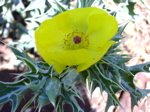On the Origins of New Forms of Life
2.3: Heterosis and Synergistic Effects
(Continued from the previous page)
 Antirrhinum
Antirrhinum
Heterosis and Synergistic Effects. Heterosis, broadly speaking, refers to any hybrid trait falling outside the range of parental variation. Such traits are said to be "heterotic."¹
That hybrids need not be intermediate with respect to every trait has long been recognized. In his book Evolution by Means of Hybridization (1916), Lotsy noted hybrids in the snapdragon genus Antirrhinum had certain characteristics that were entirely different from those of the original parents. Thus, when he crossed Antirrhinum glutinosum and A. majus, he found individuals in the F₂ generation with flowers like those seen in the related genus Rhinanthus (although both parents produce flowers that are typical of the genus Antirrhinum).² In the F₄ generation he was able to stabilize a new, true-breeding type.
 Mexican Pricklypoppy
Mexican PricklypoppyArgemone mexicana
 Rough Pricklypoppy
Rough PricklypoppyArgemone platyceras
Hagedoorn and Hagedoorn (1921) note that several strongly aberrant types appeared in the F₂ generation derived from the cross Argemone mexicana × A. platyceras (Mexican pricklypoppy × rough pricklypoppy). Some differed from either parent with respect to characteristics usually considered fundamental with respect to taxonomic classification (such as sepal and carpel number). The reader can see that many of the violet hybrids produced by Brainerd (Figure 2.1) have leaf shapes that are not obviously intermediate between the leaf shapes seen in their parents.
Any trait can be heterotic, but most reports of heterosis involve the overall size of the hybrids. The California redwood (Sequoia sempervirens), thought to be of hybrid origin,³ is the tallest tree in the world. Therefore, with respect to height, it is certainly not intermediate between its probable parents, the giant sequoia (Sequoiadendron giganteum) and dawn redwood (Metasequoia glyptostroboides).
Hybrids between the Bactrian Camel (Camelus bactrianus) and the Dromedary (C. dromedarius), which are partially fertile in both sexes, have long been bred because they are larger, more tolerant, and easier to work with than either parent.⁴ According to Lakoza (1938)
Gray (1972, p. 161) states that these hybrids
Hybrids between Siberian Crane (Grus leucogeranus) and White-naped Crane (G. vipio) are bigger than either of their parents (Maksudov and Panchenko 2002: 199).
Similarly, the hybrid produced by a lion and a tigress (known as a "liger") is usually larger and stronger than either of its parents, whereas the reciprocal cross produces a hybrid (the "tigon") that tends to be smaller than either of its parents (Gray 1972, McCarthy, in prep.). The former cross, then, is an example of positive heterosis, in which the hybrid exceeds the range of variation exhibited by its parents, while the latter is an example of negative heterosis, in which the hybrid falls below the range of parental variation with respect to a given trait.
Nevertheless, the typical hybrid, produced by the typical hybrid cross, is intermediate in size. For this reason, Stebbins (1950: 285), speaking before the advent of modern molecular techniques for the identification of natural hybrids, noted that
This factor, then, must surely have contributed to underreporting of nonintermediate natural hybrids.
Heterosis is of particular evolutionary interest because it allows hybridization to produce new traits beyond the range of ordinary parental variation. For example, in Algeria Ophrys murbeckii, an orchid of the Atlas Mountains, is derived from hybridization between O. fusca and O. lutea, but it occurs at higher altitudes than either of its parents.⁵
Johnson and Leefe (1999: 1065) report that the snail Campeloma parthenum (Maiden Campeloma) has a five-fold greater survival rate under stressful conditions than one of the parents that crossed to produce it, C. geniculum (Ovate Campeloma).
Grant and Grant (1996b) showed hybrid Galapagos finches (genus Geospiza) were more fit than their parents following an El Niño climatic perturbation event; the hybrids were better able to feed on the seeds of the plants present after the event.
In some crosses, the hybrids produced are actually more viable and vigorous than either parental type. For example, Rockwell et al. (1961) say
Given the fact that evolutionary biologists so often emphasize that hybrids are inviable — as in fact many are — it's ironic that the phenomenon of hybrid vigor is so widely recognized by breeders. It is an extremely common, even typical, phenomenon.
|
|
|
Bluegill Lepomis macrochirus (click to enlarge) |
In certain sunfish crosses (genus Lepomis) the hybrids are more vigorous and aggressive than their parents. Manwell et al. (1963) showed that this positive heterosis was, at least in part, the result of an enhanced blood chemistry, combining factors from both parents.⁷ Thus, synergy, the emergence of a new, nonintermediate trait as the result of the combination of two or more traits not previously associated in a single organism, often gives rise to nonintermediate traits in hybrids, just as the combination of two gases (e.g., hydrogen and oxygen) can produce a liquid (water). In this connection it is important to consider that the expression of any hereditary trait in any organism is the result of a complex interaction of molecules at the genetic level. In hybrids such interactions are of a novel, untried nature and can have unexpected effects.
Moreover, if a hybrid derived from a cross between two parents is crossed again with a third type of parent, the compound hybrid so obtained can have traits that are not intermediate between those of the first two parents. As we saw in the previous section, both domestic and wild compound hybrids are common. There are many examples of hybrids having traits not found in either of their parents. For example, hybrids between Audubons Oriole (Icterus graduacauda) the Altamira Oriole (I. gularis), which occur along the eastern border of the U.S. and Mexico, have streaking on their upper backs even though both their parents lack this trait.
Darwin and Heterosis. Even as a young man, Darwin was aware that hybrids need not be intermediate. In his Voyages of the Adventure and Beagle (1839) he remarks that
Moreover, his later writings clearly show he was familiar with the phenomenon of heterosis. In particular, in Variation of Animals and Plants under Domestication he shows he knew non-intermediate hybrids had been repeatedly reported by a wide variety of breeders and investigators (click here to read an extended excerpt from Variation on the topic of heterosis >>).
Variation, of course, has never been as popular or influential as the Origin of Species. However, Darwin's extensive knowledge of the effects of hybridization, and of heterosis specifically, is not reflected in the Origin, where he used the incorrect claim that hybrids are always intermediate to discount the idea that new types of organisms can be derived from hybridization. For example, every edition of the Origin published during his lifetime contained the following statement:
In this way a false claim became an axiom of subsequent evolutionary thought. NEXT PAGE >>
1. In connection with natural stabilized hybrids, Stebbins (1959: 245) uses the term transgressive, instead of heterosis, for traits exceeding the limits of variation found in either parent.
2. See also: Lotsy (1915).
3. Hirayoshi and Nakamura (1943); Li (1987); Stebbins (1948, 1959).
4. Kushner and Kitaeva (1938b); Lakoza (1938); McCarthy (in prep.); Potts (2004); Tapper (1985).
5. Stebbins (1969); Stebbins and Ferlan (1956).
6. Rockwell et al. (1961: 203–204).
7. Manwell et al. (1963) also analyzed hemoglobin in bass (Micropterus) hybrids. They reported that hemoglobins identical to those seen in the hybrids could be produced by mixing in vitro hemoglobin subunits otherwise found only separately in the two parents, which resulted in heterosis. This phenomenon of hybrids assembling proteins from two subunits derived from different parents is common. For an example see Isaacs (1970).
8. Darwin (1839: vol. III, 384–385).
9. Darwin (1859: 20; 1872: 15).
Most shared on Macroevolution.net:
Human Origins: Are we hybrids?
On the Origins of New Forms of Life
Mammalian Hybrids
Cat-rabbit Hybrids: Fact or fiction?
Famous Biologists
Dog-cow Hybrids
Georges Cuvier: A Biography
Prothero: A Rebuttal
Branches of Biology
Dog-fox Hybrids